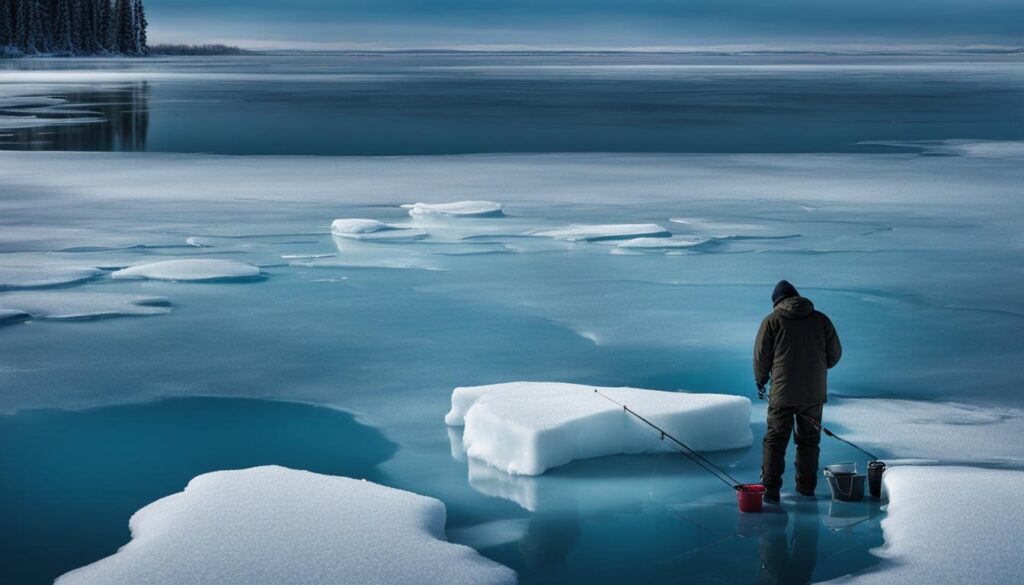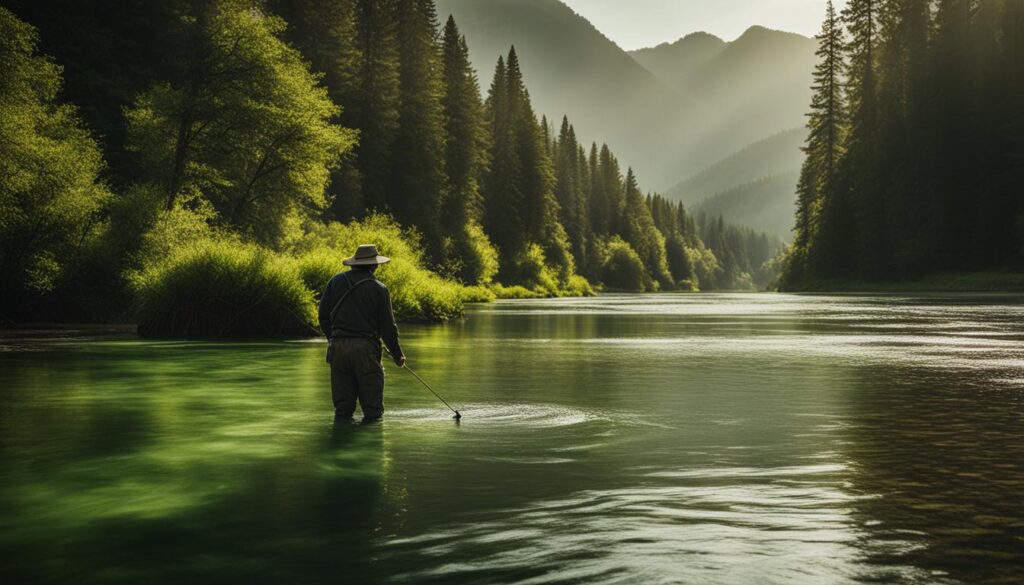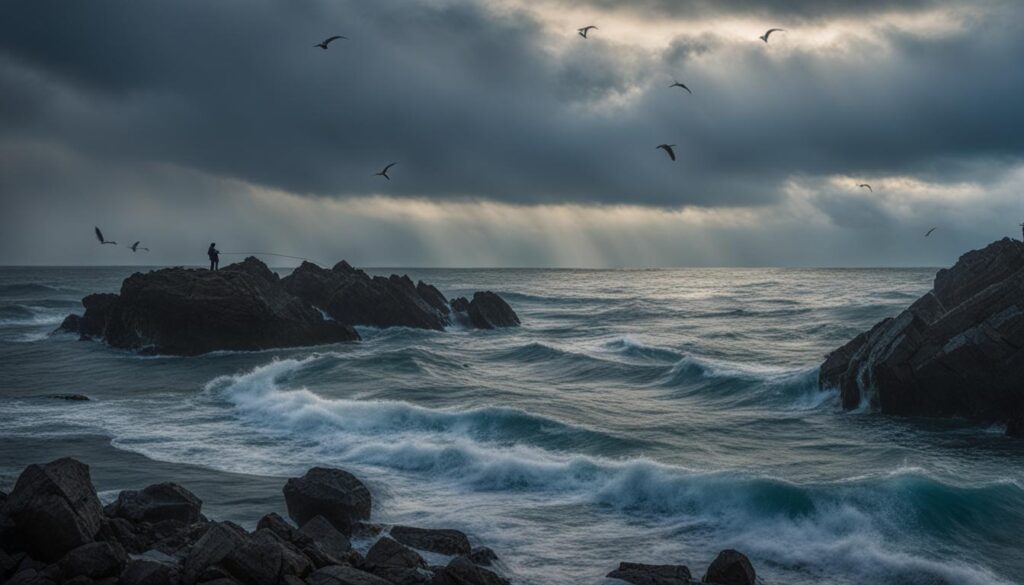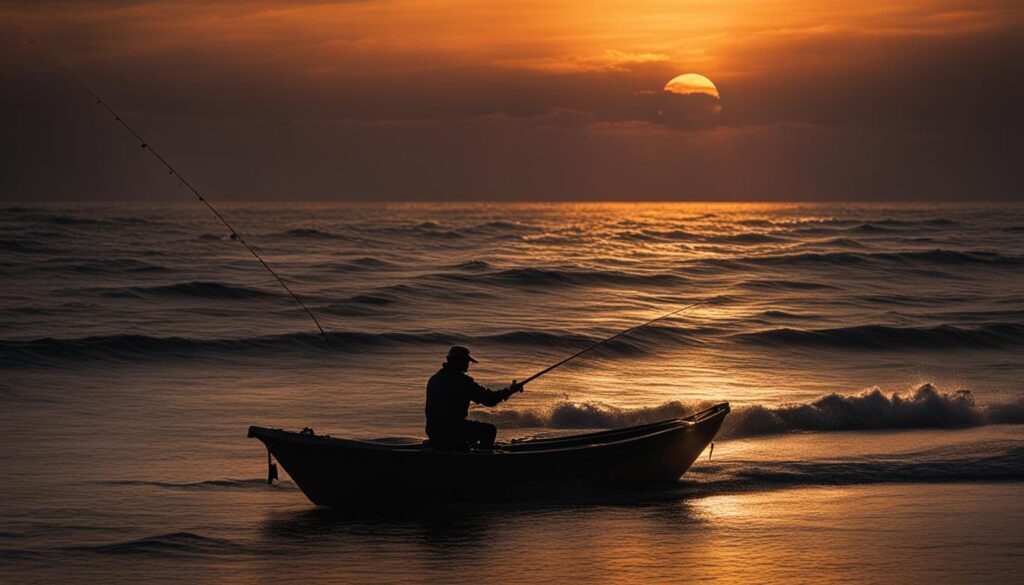We may earn money or products from the companies mentioned in this post.
Ice fishing is a unique and thrilling way to catch fish during the winter months. However, it requires a specific set of skills and equipment to be successful on the ice. In this section, we will explore essential ice fishing techniques that every angler should know. From gear and equipment recommendations to tips and tricks, this guide will provide you with everything you need to know to catch fish under the ice.
Key Takeaways:
- Understanding the basics of ice fishing is crucial before diving into advanced techniques.
- Choosing the right gear and equipment greatly impacts your chances of success on the ice.
- Mastering various ice fishing techniques, such as jigging and dead-sticking, can increase your catch rate.
- Advanced strategies, such as identifying productive fishing spots, can further enhance your success on the ice.
- Prioritizing safety and following proper etiquette are essential while ice fishing.
Understanding Ice Fishing Basics
Ice fishing is an exciting winter sport that requires some essential gear and techniques specific to this activity. If you’re new to ice fishing, there are some critical basics you should know before heading out onto the ice.
Ice Fishing Gear and Equipment
Before going ice fishing, it’s crucial to ensure you have the right gear and equipment. You will need warm, waterproof clothing, such as insulated bibs, jacket, and boots. You should also have ice fishing boots with gripping soles for traction on the slippery surface.
Ice fishing gear includes an ice fishing rod, reel, line, and tackle. The type of gear and equipment you need will depend on the fish you are targeting and the technique you plan to use. Generally, a shorter ice fishing rod is recommended, ranging from 18 to 36 inches, with a light or ultra-light power rating.
The ice fishing reel should have a smooth drag system, while the line should be monofilament or fluorocarbon, with a test strength of four to eight pounds. As for the tackle, jigs, and spoons, are popular choices for ice fishing.
Ice Fishing Techniques for Beginners
If you’re new to ice fishing, some techniques will help you get started and improve your catch rate. Jigging is the most common technique and involves dropping a jig, baited with wax worms, spikes, or minnows, to the bottom. Then, lifting and lowering the jig to attract nearby fish.
Another technique for beginners is dead sticking, which is a passive method of leaving a baited hook suspended in the water column. Then, waiting patiently for a fish to bite. Tip-ups are also ideal for beginners, which involves suspending a baited hook under a flag that signals when a fish has taken the bait.
Ice Fishing Tips and Tricks
Here are some additional tips and tricks to help you get the most out of your ice fishing experience:
- Check the ice thickness before heading out onto the lake. The ice should be at least four inches thick for walking and six to eight inches thick for driving a snowmobile or ATV.
- Arrive early in the morning or late in the afternoon since fish are more active at these times.
- Try different techniques and depths until you find success.
- Be sure to bring snacks and drinks to stay hydrated and energized during your time on the ice.
Now that you have an understanding of the fundamental basics of ice fishing, you can focus on mastering the techniques and choosing the right gear for your next expedition.
Choosing the Right Ice Fishing Gear
Ice fishing gear is essential for a successful expedition. Selecting the right equipment can make a significant difference in your fishing experience. In this section, we will explore the necessary ice fishing gear and equipment recommended for beginners and experienced anglers.
Ice Fishing Rods and Reels
Ice fishing rods are shorter than regular fishing rods and are designed to provide greater sensitivity and strength. These rods can range from 24 to 36 inches in length, and their actions can vary from slow to fast. When selecting an ice fishing rod, consider its sensitivity, strength, and the type of fish you will be catching.
Ice fishing reels are another essential piece of gear. Spincast reels, spinning reels, and baitcasting reels can all be used for ice fishing. When selecting an ice fishing reel, pay attention to its gear ratio, which indicates the number of revolutions the spool makes with one turn of the reel handle.
Ice Fishing Line
When it comes to ice fishing line, monofilament and fluorocarbon are the most commonly used. Monofilament line is less visible to fish and has some stretch, making it an excellent choice for beginners. Fluorocarbon line is more resistant to abrasion and is virtually invisible in the water, making it ideal for clear, shallow waters.
Ice Fishing Tackle
Ice fishing tackle includes jigs, spoons, and baits. Jigs are versatile and can be used for most species of fish. Spoons are ideal for catching larger fish, while baits such as nightcrawlers and minnows are great for attracting panfish.
Ice Auger
An ice auger is an essential piece of equipment for ice fishing, as it is used to create holes in the ice. Hand augers are less expensive and quieter, making them suitable for smaller, shallower bodies of water. Power augers are faster and easier to use, making them ideal for larger and thicker ice.
Table: Ice Fishing Gear Recommendations
| Equipment | Recommended for Beginners | Recommended for Experienced Anglers |
|---|---|---|
| Ice Fishing Rod | Medium-fast, 24-30 inches, sensitive | Fast, 30-36 inches, sensitive and strong |
| Ice Fishing Reel | Spincast or Spinning, with a gear ratio of 4:1 to 5:1 | Baitcasting, with a gear ratio of 6:1 to 7:1 |
| Ice Fishing Line | Monofilament, 4-6 lb test | Fluorocarbon, 4-8 lb test |
| Ice Fishing Tackle | Jigs and spoons, size 10-14 | Jigs, spoons, and baits, size 6-10 |
| Ice Auger | Hand auger, 6-8 inches | Power auger, 8-10 inches |
Choosing the right ice fishing gear is crucial for a successful expedition. Consider the type of fish you will be catching, the depth of the water, and the thickness of the ice when selecting your gear. Remember to prioritize safety and always check the ice thickness before venturing onto the ice.
Mastering Ice Fishing Techniques
When it comes to ice fishing, mastering the techniques is crucial for success. Experienced anglers rely on various techniques, from jigging and dead sticking to tip-ups and tip-downs, to catch fish under the ice. In this section, we’ll discuss these techniques in detail and provide tips to help you improve your skills.
Jigging
Jigging is an effective technique for catching fish that are actively feeding. It involves using a jigging rod and a lure to create motion in the water, imitating the movement of prey. To jig, drop the lure to the desired depth, and then use short, sharp movements to create a bouncing action. Remember to vary the speed and depth of your jigging to increase your chances of catching fish.
Dead Sticking
Dead sticking is a technique for catching fish that are less active. It involves using a stationary bait, such as a minnow or worm, and waiting for the fish to bite. To dead stick, set up your bait on a rod and then let it sit in the water. Be patient and wait for the fish to come to you.
Tip-Ups and Tip-Downs
Tip-ups and tip-downs are popular techniques for catching larger fish, such as pike or walleye. They involve using a device that alerts you when a fish has taken the bait. A tip-up is a device that “tips up” when a fish takes the bait, while a tip-down is a device that “tips down.” These devices allow you to fish multiple holes at once and can increase your chances of catching fish.
Ice Fishing Tricks and Secrets
Experienced anglers often have their own tricks and secrets for catching fish under the ice. One tip is to use a fish finder to locate schools of fish. Another is to use live bait instead of artificial lures, as fish tend to be less active in the cold water and may be less inclined to go after a lure. Additionally, changing the color of your bait or lure can also make a difference in attracting fish.
By mastering these ice fishing techniques, you can increase your chances of success on the ice. Remember to be patient and experiment with different techniques to find what works best for you. Happy fishing!
Advanced Ice Fishing Strategies
Now that you have mastered the basic ice fishing techniques, it’s time to take your skills to the next level with advanced strategies. These ice fishing tips and strategies will help you increase your chances of catching fish and make the most out of your time on the ice.
Identifying Productive Fishing Spots
One of the keys to successful ice fishing is finding the right location. You can use a fish finder or a depth finder to locate prime spots under the ice. However, it’s also important to pay attention to the environment around you. Look for areas with structure, such as drop-offs, weed beds, and rock piles, as these spots often attract fish.
Adapting to Changing Conditions
Ice fishing conditions can change quickly, and it’s important to adapt your strategies accordingly. Pay attention to the weather and the time of day, and adjust your presentation and location accordingly. For example, on sunny days, fish may be more active and closer to the surface, while on overcast days, they may be deeper in the water column.
Exploring New Techniques
There are many ice fishing techniques that are not commonly used, but can be highly effective in certain situations. For example, using a small jigging spoon with a dropper rig can entice finicky fish to bite. You can also experiment with different colors, sizes, and types of bait to see what works best in your fishing spot.
Increasing Your Chances of Success
There are also several additional strategies that can improve your chances of success on the ice. Consider fishing early in the morning or late in the evening when fish may be more active. You can also try chumming, or using live bait such as minnows or worms to attract fish to your location.
By implementing these advanced ice fishing strategies, you can take your skills to the next level and increase your chances of catching fish under the ice.
Staying Safe on the Ice
Ice fishing is an exciting and rewarding activity, but safety should always be the top priority. Follow these essential ice fishing safety tips to ensure a fun and safe experience on the ice.
- Check the Ice Thickness: Before venturing onto the ice, make sure it is at least 4 inches thick for walking and 8-12 inches thick for vehicles.
- Wear Proper Clothing: Dress in layers and wear waterproof boots, gloves, and a hat to stay warm and dry.
- Bring Safety Gear: Always carry a ice chisel, rope, and personal flotation device (PFD) in case of an emergency.
- Fishing with a Partner: Never ice fish alone. Always bring a partner and let someone know where you are going and when you expect to return.
- Be Cautious Near Moving Water: Avoid ice fishing near streams, currents, and inlets, as the ice may be weaker in these areas.
- Monitor the Weather: Stay aware of weather conditions and avoid ice fishing during severe weather, as this can impact the stability of the ice.
By following these ice fishing safety tips, you can enjoy a fun and safe experience on the ice.
Essential Ice Fishing Etiquette
Ice fishing is not only a sport but also an opportunity to connect with nature and enjoy the great outdoors. As responsible anglers, it’s crucial to follow proper ice fishing etiquette to respect the environment and maintain a positive experience for everyone involved.
Respect Other Anglers
When sharing the ice with other fishermen, it’s important to respect their space and avoid interrupting their fishing. Keep your distance, and avoid fishing too close to other anglers. If you want to move closer to them or try a spot where someone else is fishing, always ask for permission first.
Leave No Trace
When fishing on a frozen lake or pond, it’s important to leave no trace behind. Make sure to pack out all trash, including fishing line, bait containers, and food wrappers. Never discard anything on the ice or in the water.
Respect the Environment
As anglers, we have a responsibility to protect the environment and conserve our natural resources. Avoid damaging the ice or surrounding landscape. If you dig a hole, make sure to fill it back up before you leave. Avoid using live bait if possible, as it can introduce invasive species into the water.
Follow the Rules
Make sure to familiarize yourself with the specific rules and regulations of the body of water you are fishing on. Follow any size or creel limits, and avoid fishing in off-limit areas. If you’re unsure about the rules, check with local authorities or other experienced anglers before you start fishing.
By following these essential ice fishing etiquette tips, you can ensure a positive and respectful experience for all anglers while enjoying the thrill of fishing on the ice.
Conclusion
Ice fishing is a thrilling and rewarding winter activity that requires knowledge, practice, and patience. By mastering essential ice fishing techniques, you can increase your chances of success on the frozen lakes. Remember to always prioritize safety, invest in the right gear, and follow proper etiquette to maintain a positive experience for everyone involved.
Whether you’re a beginner or an experienced angler, there’s always something new to learn in the world of ice fishing. Take the time to understand the basics, try out various techniques, and explore advanced strategies to expand your knowledge and skills.
The Joy of Ice Fishing
Ice fishing is not just about catching fish; it’s about connecting with nature and enjoying the beauty of winter landscapes. Whether you’re fishing alone or with friends and family, there’s a sense of serenity and relaxation that comes with spending time on the ice.
So, grab your gear, bundle up, and head out to explore the secrets of the frozen lakes. With patience, determination, and a little bit of luck, you might just catch the biggest fish of your life.
FAQ
What are some essential ice fishing techniques for beginners?
Some essential ice fishing techniques for beginners include jigging, dead sticking, and using tip-ups. These techniques are effective in attracting fish and increasing your chances of catching them.
What gear and equipment do I need for ice fishing?
For ice fishing, you will need an ice fishing rod, reel, line, and tackle. It’s important to choose gear that is suitable for the specific ice fishing technique you plan to use.
How do I stay safe while ice fishing?
Safety is paramount when ice fishing. Make sure to check the thickness of the ice before venturing out, wear appropriate clothing, and always fish with a partner. Additionally, carrying safety equipment such as ice picks and a life jacket is highly recommended.
What is ice fishing etiquette?
Ice fishing etiquette involves following certain rules and considerations. This includes respecting other anglers’ space, properly disposing of trash, and minimizing your impact on the environment. It’s important to be courteous and considerate while enjoying the ice fishing experience.
Affiliate Disclosure: This post may contain affiliate links. If you purchase through our link, we may receive a small commission, but at no additional cost to you. For more information, please see our Disclosure statement.



